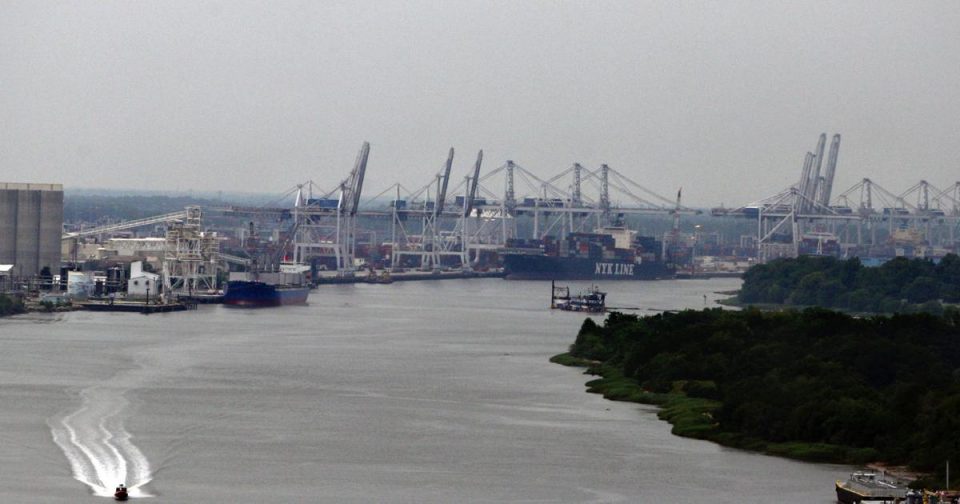Development of the Jasper Ocean Terminal in South Carolina’s Lowcountry is on the back burner again with news that the Georgia Ports Authority plans to build its next cargo container terminal on Hutchinson Island near the Port of Savannah.
The long-planned Jasper County terminal, which would be built on South Carolina’s side of the Savannah River, would be a partnership between that county and the Georgia Ports Authority. Jasper County took over a 50 percent share in the project earlier this year when the S.C. State Ports Authority assigned its part of the joint venture to the county in a deal to garner legislative support for a rail yard near the new Leatherman Terminal in North Charleston.
Peach State officials this summer told Jasper County they needed until the end of this year to determine which project they wanted first — the Jasper Ocean Terminal or a new facility on about 250 acres the GPA owns on Hutchinson Island.
Apparently, Hutchinson Island is the first choice.
“Jasper … is a long-range plan. We can’t wait for Jasper,” Christopher Novack, the GPA’s senior director of engineering and facilities maintenance, told those attending an American Council of Engineering Companies seminar last week in Charleston.
Savannah is the nation’s fastest-growing port with a 67.5 percent increase in cargo containers between 2017 and 2020. The Port of Charleston, by comparison, has seen 21.5 percent growth during that period. Savannah’s port handled 5.3 million containers during fiscal 2021, which ended June 30 — a 20 percent increase over the previous year. Charleston’s port handled 2.55 million containers — 9.6 percent better than the previous year.
Novack said Savannah’s Garden City Terminal is reaching capacity, so development of Hutchinson Island — which would give the port capacity for another 2 million containers — will be necessary in the next few years.
“The mid-term is going to be Hutchinson Island, and then long term is Jasper,” Novack said. He declined to say how long term development of the Jasper Ocean Terminal will be.
“That’s a hard question to answer,” he told the engineering group. “In any event, we’re still working with our friends in South Carolina. It’s a long-term vision and a long-term program. But I really couldn’t give you a feel for the timing at this point.”
There’s been little progress on the roughly 1,500-acre Jasper terminal in the 15 years since rival port agencies in South Carolina and Georgia formed a joint venture to develop the site. The two states have spent a combined $19.5 million on preliminary environmental studies for the proposed container terminal, which has a price tag of more than $5 billion.
Jasper County officials see the terminal as an economic necessity and state Sen. Tom Davis, a Beaufort Republican, has worked tirelessly to make it a reality.
Davis has said development of Hutchinson Island “is of great concern” because a new terminal there “would materially impact in a negative way the timeline” for Jasper Ocean Terminal.
Davis led the effort in the S.C. Legislature to transfer South Carolina’s interest in the terminal to Jasper County in an attempt to speed up its construction, which had been pushed to between 2035 and 2040 when the new Leatherman Terminal added capacity to Charleston’s port. With a new Hutchinson Island terminal apparently in the works, that timeframe — if not later — now seems likely once again.
Chip gains
The global computer chip shortage that’s crimped production at Volvo Cars is easing but will last well into 2022, the automaker that builds S60 sedans in Berkeley County said last week.
“The supply situation has improved going into the fourth quarter, but we expect the industry-wide shortage of semiconductors to remain a restraining factor,” Hakan Samuelsson, Volvo’s CEO, said in a statement.
Samuelsson said production remains lower than demand, but the situation has “improved month by month” since September. The automaker sees the chip shortage as a bigger threat to future production than any COVID-related shutdowns, he said.
The statements were part of Volvo’s third-quarter financial presentation — its first since going public in late October. Volvo announced third-quarter operating profit figure of $362.6 million, down about 18 percent from $442 million a year ago. Revenues declined 7 percent to about $6.7 billion.
Volvo, majority owned by China’s Geely Holding Group, raised about $2.2 billion in one of Europe’s biggest IPOs this year. The company has committed to building only electric vehicles by 2030, including a next-generation XC90 SUV that will be added to the production line at Volvo’s $1.1 billion manufacturing campus in Ridgeville.
Reach David Wren at 843-937-5550 or on Twitter at @David_Wren_


